A delightful Visit to Ísafjörður - the Capital City of the Westfjords of Iceland

With the fishmonger Kári in Ísafjörður town
This travel-blog is a part of my travel-blog series about the northern part of the Westfjords of Iceland.
We are coming from Súðavík village and Langeyri in Álftafjörður where we stayed for the night and will now be staying in Ísafjörður town in Skutulsfjörður fjord.

Arnardalshamar tunnel
In my last travel-blog, we drove through the oldest tunnel in Iceland, an approx. 30-35 m long tunnel in Arnardalshamar (Arnarneshamar).
Arnardalshamar is a basalt dyke reaching into the sea between Skutulsfjörður and Álftafjörður and it was a very difficult task back then drilling a hole through it to reach the other side.
The tunnel was ready in December 1948 and opened to traffic in 1949 when the road was ready, creating easy access to Álftafjörður and Súðavík village from Skutulsfjörður.

Ísafjörður town
Ísafjörður town is the capital city of the Westfjords of Iceland with a population of around 2,736 people (2020), making it the largest town in the Westfjords. Ísafjörður got its municipal rights back in 1866.
Ísafjörður town stands by Skutulsfjörður fjord, not by Ísafjörður fjord, as one would have imagined. Ísafjörður fjord, on the other hand, is a small fjord further east on the northern side of the Westfjords.
I guess that this must be a bit confusing to foreigners visiting the Westfjords for the first time.

Ísafjörður town
If you have been following my travel-blog series where I show you the northern part of the Westfjords then Ísafjörður fjord is the first fjord we encountered before reaching Reykjanes, where I stayed for the night: A lovely Visit to Reykjanes in the Westfjords of Iceland.
The huge fjord though, by which all these northern fjords stand is called Ísafjarðardjúp.
And we Icelanders say that we will be driving Djúpið - the Deep when driving on the northern side of the Westfjords.
Ísafjörður town
Ísafjörður town translates into the Town of the ice or the drift ice. From what I have heard then the Danish merchants named it after Ísafjarðardjúp.
According to the 50th chapter in Landnámabók - the Book of Settlements in Iceland, the first settlers in Skutulsfjörður were Helgi Hrólfsson and Þórólfur brækir (who settled in Skálavík).
Helgi found a harpoon on the shoreside and apparently named the fjord after the harpoon - skutull in Icelandic - Harpoon fjord.
The yellow house is Faktorshúsið Hæstakaupstað, which was built in 1788
I love reading Landnámabók, finding out about the settlers of Iceland and the origin of the ancient place names.
Very often the origin of the ancient places stems from the name or the nickname of the settlers.
Jónsgarður park
In the botanical garden Jónsgarður - the Garden of Jón
In Jónsgarður park - the Park of Jón, you will find the Whalebone arch with the Ísafjörður sign.
The Whalebone arch is 5-meters high, made from jawbones, which goes to show how large the whales really are.
The whalebones were moved from Uppsalaeyri in Seyðisfjörður in the Westfjords, from a Norwegian whaling station and erected here in Jónspark back in 1935. ( Ref. Jónsgarður á Ísafirði).
I told you about the Norwegian whaling stations in my last travel-blog.

The Whalebone arch in Jónsgarður
I saw a similar arch made of blue whale bones, at the botanical park Skrúður by Núpur in Dýrafjörður fjord. That arch was erected some years prior to the whalebone arch in Jónsgarður.
They were moved for safekeeping back in 2008 and whalebones from a finback put in their place.
Jónsgarður park is named after Jón Jónsson often called Jón skraddari as he was a tailor. He was the instigator of the park as he had worked as a tailor in London and loved the many parks in London, especially Kew Gardens. Jón felt that a park was missing in Ísafjörður.

The memorial for Jón and his wife Karlinna
Jón's idea was met with opposition and he was ridiculed for believing that a flower park would survive so far up north. But he didn't give up and was given a plot for a flower park.
Many of the trees and flowers didn't survive the northern climate so it was through trial and error that this park became the beautiful park it is today.
And on the 70th anniversary of the park, a memorial was erected in his honour and the park was given his name. Before it was named Jónsgaður it was called Efri-garðurinn - the Upper Park or Blómagarðurinn - the Flower Park.

Artwork in Austurvöllur park - it is called Fýkur yfir hæðir - or Moorland flight.
You will find another flower park in Ísafjörður called Austurvöllur park. It is by Austurvegur right next to Sundhöll Ísafjarðar - the Ísafjörður swimming pool.
There you will find artwork by one of Iceland's most famous sculptors, Ásmundur Sveinsson. It is called Fýkur yfir hæðir - Moorland flight and depicts a mother protecting her child from the storm.
Ísafjarðarkirkja church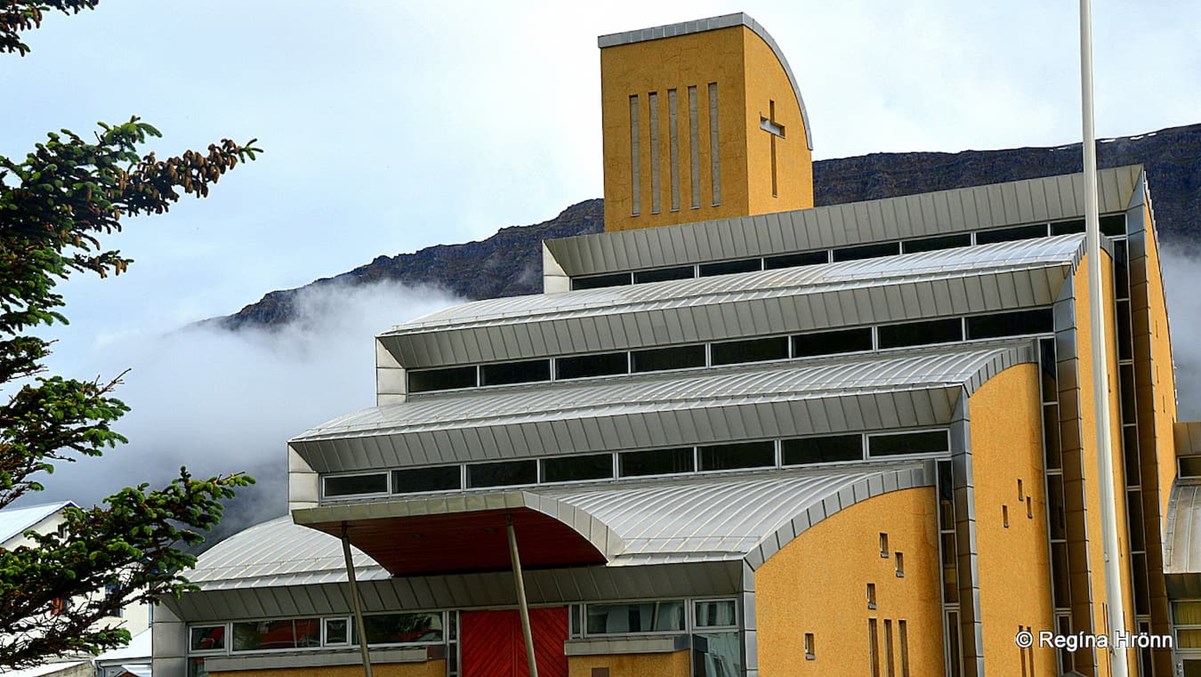
Ísafjarðarkirkja church
You cannot miss the Ísafjarðarkirkja church as it looks like big waves, a very prominent building in Ísafjörður.
It was unfortunately closed during my visit, but I would have loved to have a look inside as I have seen photos of the altarpiece which is made of 749 clay birds (plovers)
The inhabitants of Ísafjörður made these birds during Easter back in 2007 and called them Fuglar himinsins or the Birds of Heaven. You can read the folklore about the birds in Þjóðsögur Jóns Árnasonar - the Collection of Folklore by Jón Árnason, which I so often refer to in my travel-blogs.
The legend is called Lausnarinn og lóurnar.

A model of the old church
The current church was built in 1995 and designed by Hróbjartur Hróbjartsson after the old church burnt down in 1987.
At an exhibition í Ísafjörður, I saw a model depicting Ísafjörður back in 1866. There was a model of the old church, such a lovely old church, what a pity that it burnt down.
A guided tour of Ísafjörður town
Ísafjörður town
We joined a guided tour of the town by a local, called the Ísafjörður culture walk. I find being guided by locals invaluable.
The tour lasted for 1.5 - 2 hours and gave me a good insight into what life is like in the Westfjords of Iceland.
She (the guide) told us about the huge amount of snow they sometimes get in Ísafjörður, which can be so high that she has had to climb out of the upper window of the house where she was living! Ísafjörður town - I am a fan of yellow houses and noticed so many beautiful yellow houses in Ísafjörður :)
Ísafjörður town - I am a fan of yellow houses and noticed so many beautiful yellow houses in Ísafjörður :)
I love walking around the centre of Ísafjörður town; many of the houses remind me of my childhood in Reykjavík, of houses long gone so I got quite nostalgic :)
Our guide showed us artwork, which we would never have found ourselves, and told us local stories.

On the guided tour of Ísafjörður
She f.ex. showed us the 35 paintings inside one building which were painted back in 1980. Beautiful colourful work depicting the life of fishery in Ísafjörður.
Fisheries have always been the main industry in Ísafjörður town, as in most towns and villages in Iceland. In many places in Iceland, you will find a maritime museum and Ísafjörður is no exception.

On the guided tour of Ísafjörður
I highly recommend joining á guided tour of Ísafjörður, it for sure enriched my visit to Ísafjörður.
After the tour ended we went exploring the oldest part of Ísafjörður town on our own.
Neðstikaupstaður - the oldest part of Ísafjörður town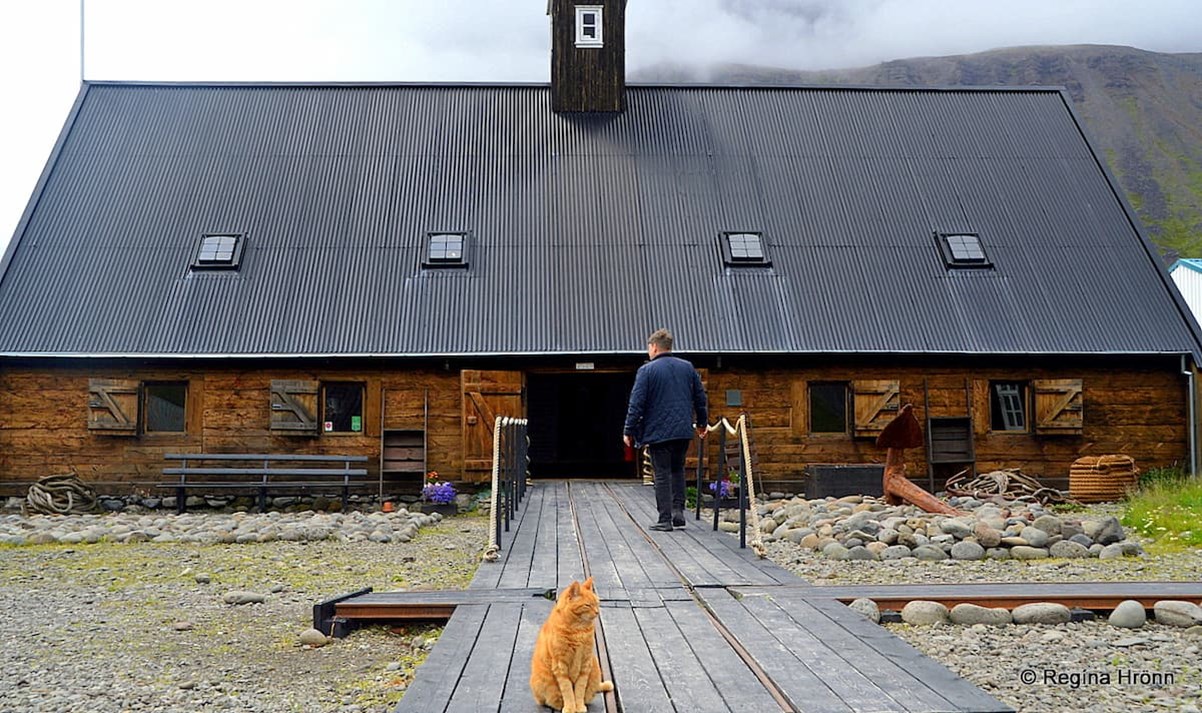
Turnhúsið from 1784
The Westfjords Maritime and Heritage Museum is located in an old building called Turnhúsið - the Tower House (built in 1784) - in Neðstikaupstaður in Ísafjörður.
In Neðstikaupstaður you will find some beautiful old, renovated timber houses from the 18th century, like Krambúðin, dating back to 1757 and Faktorshúsið from 1765.

Turnhúsið and Krambúðin - the black one
To me, this spot in Neðstikaupstaður is the most beautiful spot in Ísafjörður town, the only remainder of the old Danish monopolistic trade.
I am so glad that these houses were preserved. And I remember that my grandmother talked fondly about this beautiful part of Ísafjörður
In the summertime salted fish is still sun-dried in a plot by the museum.
Tjöruhúsið in Neðstikaupstaður built in 1781 - now a restaurant
Close by you will find a fishmonger's shop down by the harbour.
It is called Fiskbúð Sjávarfangs and is located at Sindragata 11.

Kári Þór Jóhannsson, the owner of Fiskbúð Sjávarfangs
The fishmonger, Kári Þór Jóhannsson, showed me a big salted fish, and I asked him to come outside so I could take a photo of him holding up the big salted fish for my travel-blog :)
Calm water kayaking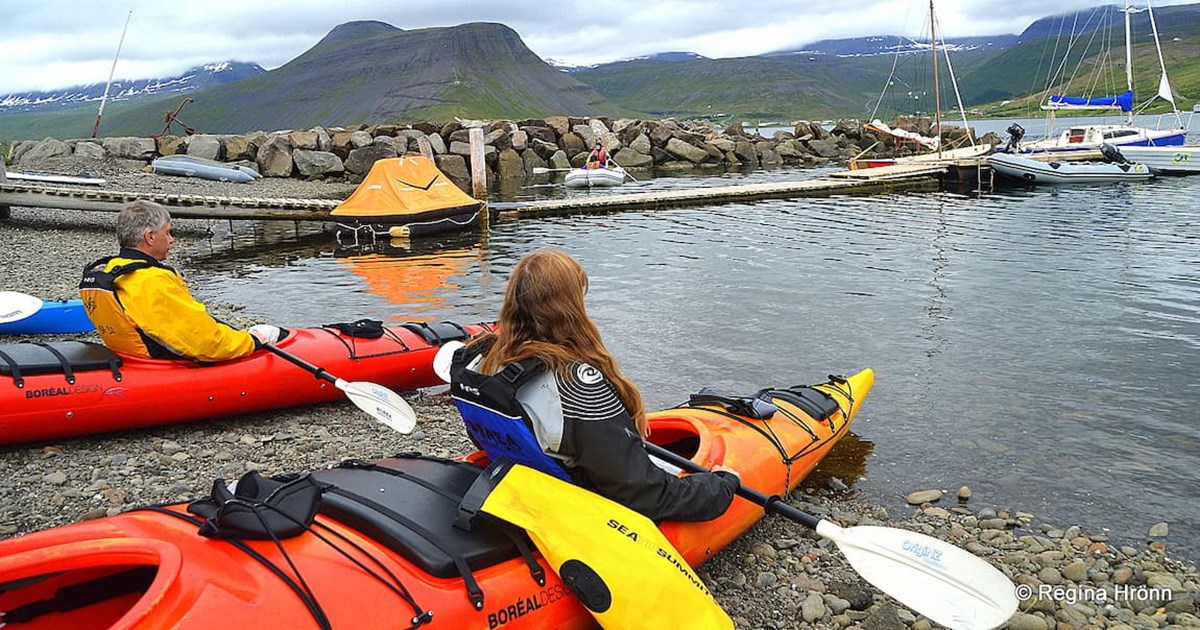
Calm water kayaking
There are many interesting tours of the Westfjords available and very popular tours take you to Hornstrandir nature reserve.
We visited Ísafjörður with the purpose of joining a day tour to Hornstrandir, which unfortunately was cancelled, so instead, I tried one of the Borea Adventures tours and went kayaking on the calm sea by Ísafjörður town called Pollur or the Puddle.
We "set sails" from the museum in Neðstikaupstaður.

Calm water kayaking
This is the first and only time that I have sailed in a kayak and doing so in calm waters in these wonderful surroundings; with tall mountains on 3 sides, was heavenly.
We were only 4 on this tour and having a guide made all the difference, especially when you are trying out a kayak for the first time in your life.
Beforehand I was certain that the kayak would capsize and I would find myself with my head underwater, but everything went well ;)
I must say though that I found it a bit taxing paddling and was grateful for my husband's help.
There are some variations of kayak tours for the more experienced, but calm water kayaking was the perfect tour for me.
Memorials for drowned fishermen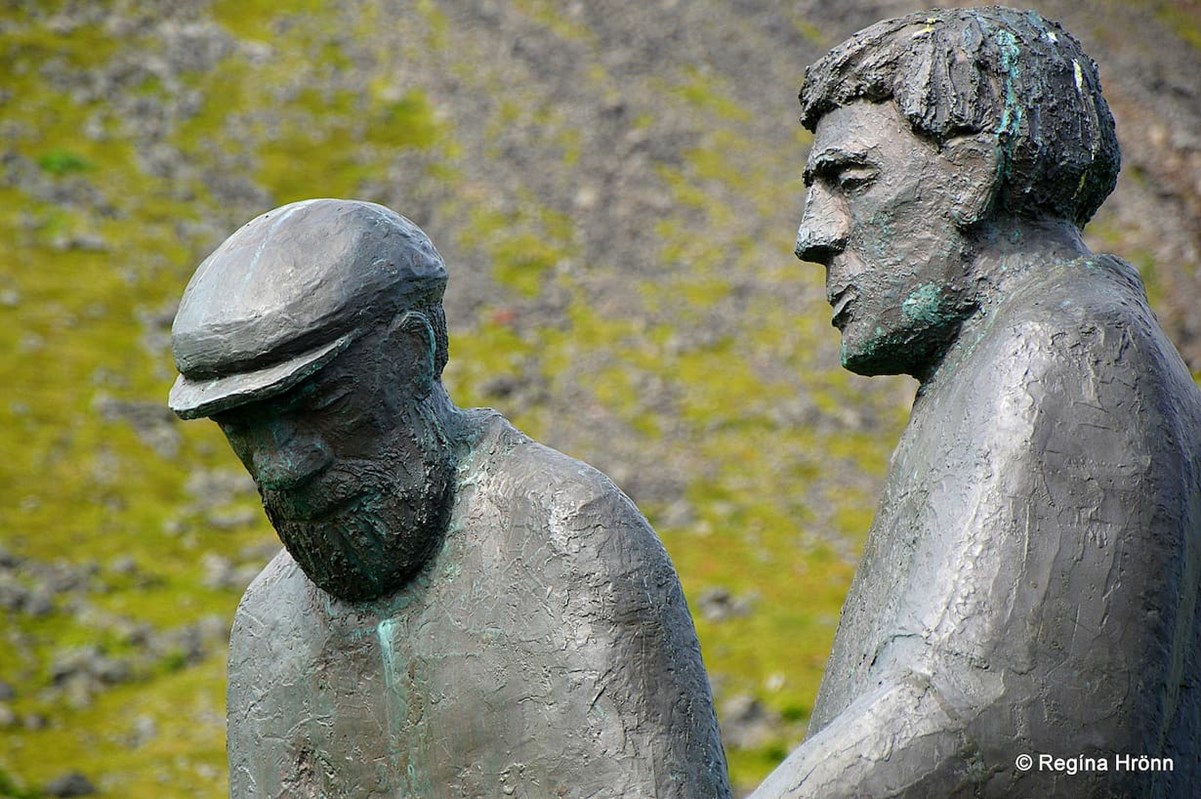
The Memorial for drowned fishermen in Ísafjörður
I always look for the Memorial for drowned fishermen - Minnisvarði um drukknaða sjómenn - in every town and village by the sea that I visit during my travels in my country.
In my opinion, these memorials are the heart of the villages.
We have lost so many men at sea during the centuries and it is heartbreaking standing by the memorials contemplating about all the lives the sea has taken from us. 
The Memorial for drowned fishermen in Ísafjörður and the Old hospital
There are 2 such memorials in Ísafjörður. There is always the main memorial for our drowned fishermen, and then there might be others that are erected in the memory of individual accidents at sea or for foreign drowned fishermen.
The memorial for drowned fishermen is located by the Old hospital, two fishermen pulling in their nets.

The Memorial for drowned fishermen in Ísafjörður
The memorial was made by the noted sculptor Ragnar Kjartansson and erected in 1974. Ragnar Kjartansson has made several well-known sculptures in Iceland, like the sculpture of Bárður Snæfellsás at Arnarstapi on the Snæfellsnes peninsula.
Written on the memorial is: "Minnisvarði ísfirskra sjómanna 1974. Til heiðurs þeim sem horfnir eru. Til heilla þem sem halda á mið" - meaning:
"A memorial for the fishermen of Ísafjörður 1974. In the honour of those who have gone. And for the good fortune of those who sail to the fishing grounds".

The memorial for lost sailors from the convoy QP13
Another memorial is located in Neðstakaupstaður close to the old houses.
It is the memorial for the sailors from the convoy QP 13 who lost their lives by the coast of Iceland by Horn on the 5th of July, 1942.
I will tell you more about convoy QP 13 in my next travel-blog about Bolungarvík, where there is another memorial for the approx. 240 people who lost their lives in this greatest marine disaster in Iceland.
See also: Russian Arctic Convoy Museum
The Old Hospital - the Culture House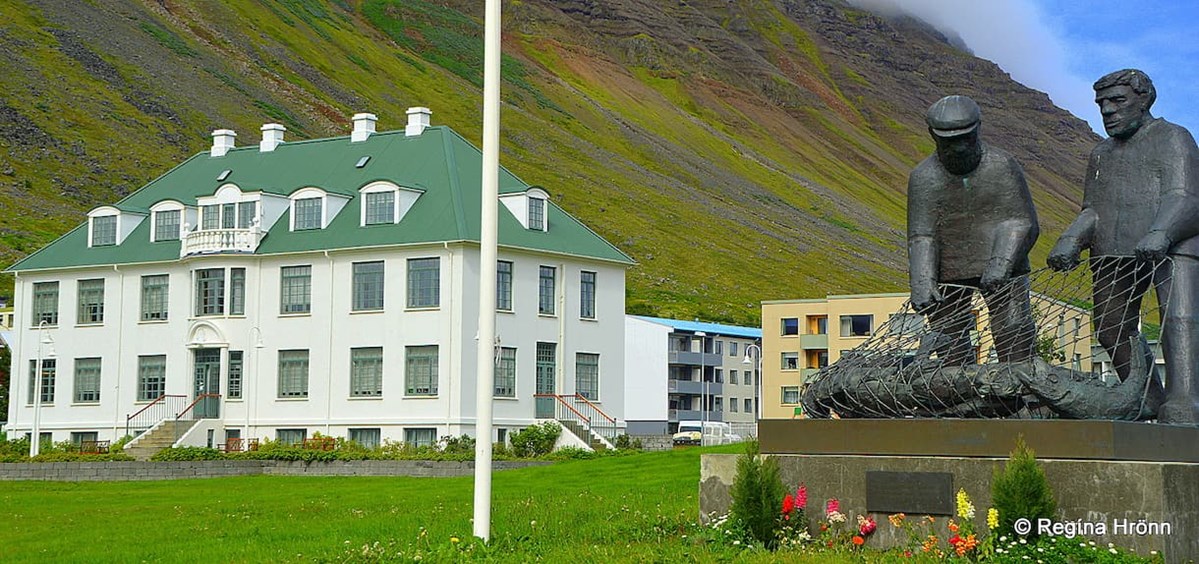
Gamli spítalinn - the Old hospital in Ísafjörður
The white and green building in my photo above, which to me is the landmark for Ísafjörður town, is the old hospital, built in 1925.
Our State architect, Guðjón Samúelsson, designed this hospital, and kudos to him for a job well done. He was the designer of many of the most beautiful buildings in Iceland.
It operated as a hospital until 1989, but the building reopened in 2003 and now serves as a culture house with a library and exhibitions and photos and tools from the old hospital.

Inside the Old hospital in Ísafjörður
I have roots in Ísafjörður and my grandmother (1923), who lived at Sæból in Ingjaldssandur in the Westfjords, worked at the hospital.
So I looked through the photos to see if I could find some photos of her when she was a young girl working at the hospital.
And imagined what she must have looked like while she was working at the hospital as a 19-year-old girl back in 1942 :)

My grandmother Kristbjörg (on the right-hand side) and her sister Árný, who worked at the Old hospital in Ísafjörður in 1942 - she had flaming red hair
In 1943 she went south to work in Reykjavík, had my mother in 1944, and settled with my grandfather in Reykjavík. She lived to be 85 and never went back to visit her beloved Westfjords.
Her father Guðmundur, my great-grandfather (1889), was born at Kleifar in Seyðisfjörður in the Westfjords and lived in 9 places in the Westfjords during his lifetime, amongst them in Ísafjörður town. He lived here from 1907-1908 with his mother in Finnbjörnshús in Skipagata 7 street in Ísafjörður.
I couldn't find the house, but this yellow house was supposedly next to it.

Ásbyrgi - this beautiful yellow house - was next to the house where my great-grandfather lived from 1907-1908
And on the 1st of April, 1908, my great-great-grandmother, Sigríður Mailína Einarsdóttir (1859), went on her final journey from Ísafjörður over the Breiðadalsheiði heath to meet up with my great-great-grandfather, Guðmundur, at Selakirkjuból in Hvilftarströnd.
She most likely wanted to ask him if their son could live with her for a longer time in Ísafjörður town and get a further education here.
It was cold and a storm coming, and she was not properly dressed for this journey. She hooked up with the postman, who advised her from accompanying him over the heath, but she was so eager to go that she didn't heed his advice.

She lost her life on the heath - died of exposure :(
The postman had to leave her on the heath and get help, but she had died when he came back with help. So sad and so many people have died of exposure in the cold winters in Iceland.
I have written another travel-blog about the remote place, Ingjaldssandur, the last place where my great-grandfather lived in the Westfjords and my grandmother was born. Ingjaldssandur is located between Önundarfjörður and Dýrafjörður fjords.
Ingjaldssandur in the Westfjords of Iceland - my Grandmother's Birthplace

At the Salvation Army planning where to go next
We stayed at Hjálpræðisherinn - the Salvation Army for the night. When travelling in the Westfjords I book the hotels on the same day and the cheapest option at Ísafjörður was the Salvation Army.
The room was basic with a view of the bins and the shower had seen better days, but the kitchen was squeaky clean, like incredibly clean for such an old house.
I had seen some reviews about the Salvation Army on Booking.com about how clean the kitchen here was and they were for sure right.

Ísafjörður town
Ísafjörður town has got an airport with a scheduled flight so you can fly over from Reykjavík if you are not up for the long drive. Cruise ships visit Ísafjörður in the summertime and this little town sees a lot of visitors in a short period of time.
In Ísafjörður you will find Bónus discount supermarket just as you enter the town, and in the centre of the town, you will find Nettó supermarket.
In the other villages in the Westfjords, you will find smaller supermarkets, but in Reykjavík, I always shop at Bónus and Nettó, so I was glad to be able to shop in these supermarkets here in the Westfjords.

The main street in Ísafjörður
We had a lovely stay in Ísafjörður, and now it was time to continue exploring the Westfjords of Iceland.
The closest villages to Ísafjörður are Hnífsdalur (4 km) and Bolungarvík (13 km) on road 61.
In my next travel-blogs, we will be driving to the end of road 61, Djúpvegur, which I have been showing you in thi series of travel-blogs.
We will stop on the way in Hnífsdalur and Bolungarvík villages and drive up on top of Mt. Bolafjall via road 630 in foggy weather.
Here is the next part in my travel-blogs series:
Hnífsdalur village in the Westfjords and the big Avalanche in 1910

Ísafjörður harbour
The travel-blogs I have written in chronological order about the northern part of the Westfjords are:
A lovely Visit to Reykjanes in the Westfjords
Vatnsfjörður in the Westfjords - the Viking Estate and Grettisvarða Cairn
Litlibær Turf House on the Hvítanes Peninsula in the Westfjords - a Cute little Turf House Café
Watching the cute Seals at Hvítanes Peninsula in the Westfjords
Visiting Súðavík Village and Langeyri in Álftafjörður in the Westfjords
A Delightful Visit to Ísafjörður - the Capital City of the Westfjords
Hnífsdalur village in the Westfjords and the big Avalanche in 1910
Visiting Bolungarvík Village - the End of Road 61

Ísafjörður habour
Here is the location of Ísafjörður town in Skutulsfjörður on Google Maps.

A map of the Westfjords
Have a lovely time in the wonderful Westfjords of Iceland :)